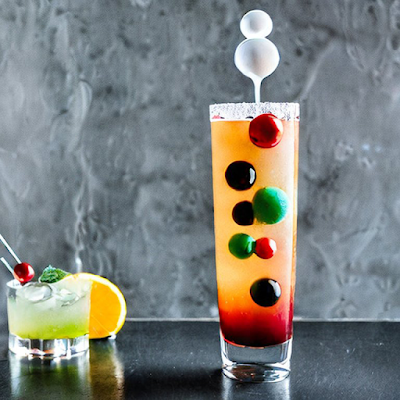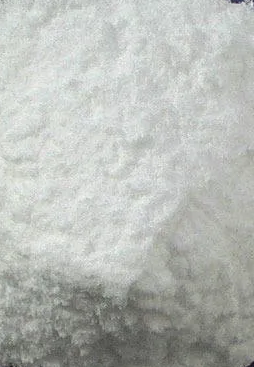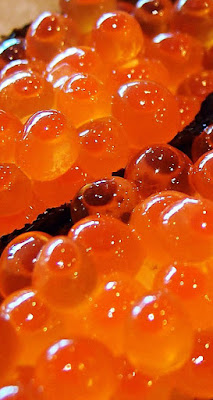What is spherification?
Spherification is a culinary technique in which a liquid is turned into a soft, bite-sized sphere that has a gelled outer layer and a liquid interior. It is often used to create small, "pearls" or "caviar" out of fruit juices, cocktails, and other flavored liquids.
The procedure of spherification involves mixing a liquid with a gelling agent, such as sodium alginate, and then dripping the mixture into a bath of calcium chloride. The calcium ions in the calcium chloride react with the alginate to form a thin, gelled membrane around the droplets of liquid.
The resulting spheres can be eaten as is or used as a garnish or ingredient in a variety of dishes.
Examples of dishes that can be made using the spherification technique include "caviar" made from fruit juices, special cocktails transformed into bite-sized spheres, and soups served with gelled droplets of broth. The possibilities for using spherification in the kitchen are endless, and the technique continues to be a popular and innovative way for chefs to add visual and textural interest to their dishes.
What do you need for spherification?
Here are the main ingredients and equipment you will need to perform spherification:
Ingredients:
A liquid to be gelled (such as fruit juice, cocktail, soup, or puree)
Sodium alginate (a gelling agent derived from brown seaweed)
Calcium chloride (a compound salt that helps the gelling process)
Equipment needed for spherification:
A blender or immersion blender (to mix the sodium alginate into the liquid)
A spoon or squeeze bottle (to drip the mixture into the calcium chloride bath)
A large bowl or container (to hold the calcium chloride bath)
A slotted spoon or small strainer (to remove the gelled spheres from the bath)
You may also want to have some additional equipment on hand, such as a kitchen scale to measure out precise amounts of ingredients, and a thermometer to ensure that the liquid is at the right temperature for the gelling process.
What is the spherification process?
The process of spherification involves mixing a liquid with a gelling agent.
The science behind spherification relies on the properties of gelling agents, specifically hydrocolloids, which are molecules that can form gels when mixed with water. There are several different types of hydrocolloids, each with its own unique properties and applications in the culinary world.
Sodium alginate is a type of hydrocolloid that is derived from brown seaweed and is commonly used in the spherification process.
Spherification Process- To start the spherification process, the liquid to be gelled is mixed with a small amount of sodium alginate using a blender or immersion blender. The mixture is then allowed to rest for a period of time, typically several hours to overnight, to allow the alginate to fully dissolve and hydrate.
This resting period is known as "hydration," and it is important to allow sufficient time for the alginate to fully hydrate to ensure that it will gel properly.
Once the mixture has hydrated, it is ready to be used in the spherification process. The mixture is typically poured into a squeeze bottle or spooned into a small strainer, and then dripped into a bath of calcium chloride.
The calcium ions in the calcium chloride react with the alginate to form a thin, gelled membrane around the droplets of liquid. The gelled spheres can then be removed from the bath using a slotted spoon or small strainer and placed in a bowl of water to rinse off any excess calcium chloride.
There are two main methods of spherification: direct spherification and reverse spherification, depending on where you put the gelling ingredient.
What is the difference between direct spherification and reverse spherification?
A) DIRECT SPHERIFICATION is a technique used to create spheres or bubbles of liquid that have a thin, semi-solid shell and a liquid interior. The liquid is mixed with a small amount of sodium alginate, which is a gelling agent derived from algae.
In direct spherification, alginate is added directly to a flavored liquid. This solution is then added drop by drop to a setting bath that contains calcium. As the calcium ions interact with the alginate, a flexible skin forms around the drop.
When the mixture is dropped into a bath of calcium chloride, the sodium alginate reacts with the calcium ions to form a gel-like membrane around the droplets of liquid. This creates the sphere or bubble shape.
B) REVERSE SPHERIFICATION, on the other hand, is a technique used to create a gel-like substance with a liquid center. To do this, the liquid that you want to turn into a gel is mixed with calcium chloride and then dropped into a bath of sodium alginate.
Instead of adding the calcium to the water bath, you instead add it to the flavored liquid which will gel in a sodium alginate bath.
The calcium ions in the liquid react with the sodium alginate to form a gel-like membrane around the droplets of liquid, creating a gel with a liquid center.
Direct spherification is typically used to create spheres or bubbles that are meant to be eaten as is, while reverse spherification is used to create a gel-like substance that can be used as a component in a dish or drink.
With reverse spherification, it's possible to make much larger spheres. The liquid center itself doesn't contain anything that will gel, so the sphere can never become entirely solid.
Reverse spherification is the most common method of spherification and is generally considered to be the more stable and reliable of the two methods.
It is also the method that is most commonly used in professional kitchens.
Related Post: 10 Best Molecular Gastronomy Kits 2023 that Will Help You Cook Easily Like a PRO
What do I need for reverse spherification?
To produce Reverse Spherification, you need a bath solution with 0.5% sodium alginate (0.5 g per 100 g of flavored liquid). Sodium Alginate, like most hydrocolloids, needs to be dispersed in the liquid and hydrated before it can gel in presence of calcium ions.
What is the process of reverse spherification?
The process of reverse spherification involves the following steps:
It is similar to traditional spherification, but the order of the steps is reversed.
1) Create a sodium alginate bath by mixing a sodium alginate solution with a calcium lactate solution. Allow the mixture to rest for several hours to overnight to allow the alginate to fully hydrate.
The amount of calcium chloride needed will depend on the size of the container and the desired concentration of the solution.
2) Place the liquid or puree that you want to turn into a sphere into a squeeze bottle or a pipette.
3) Slowly drip the liquid or puree into the sodium alginate bath, allowing it to form into a sphere. The gelled spheres will begin to form as soon as the mixture comes into contact with the calcium chloride.
4) Allow the spheres to sit in the bath for a few minutes to set.
5) Carefully remove the spheres from the bath and rinse them in cold water to remove any excess sodium alginate solution.
Once the gelled spheres have been rinsed, they can be transferred to a container of water or a liquid of your choice. The spheres will continue to gel and firm up over the next several hours.
6) Serve the spheres immediately, or store them in a container filled with a liquid (such as water or a flavored liquid) until ready to serve.
The gelled spheres can be served as is, or they can be used as a garnish or ingredient in a variety of dishes.
Reverse spherification can be used to create a variety of creative and visually appealing dishes, such as "caviar" made from fruit purees or cocktails served in a sphere form.
How long does reverse spherification last?
The liquid center itself doesn't contain anything that will gel, so the sphere can never become entirely solid. Thus, spheres prepared by reverse spherification can be can be kept indefinitely.
You can try this easy molecular gastronomy recipe at home, Yogurt Spheres Recipe by Reverse Spherification- Molecular Gastronomy Recipe
What is the process of direct spherification?
Direct spherification is a slightly different process, and it involves the following steps:
1) Begin by preparing your flavored liquid and gelling agent. The gelling agent you choose will depend on the type of liquid you are using and the desired texture of the final product. Sodium alginate is a common choice for direct spherification, as it reacts well with calcium to create a firm, caviar-like texture.
2) Mix the gelling agent into the flavored liquid according to the manufacturer's instructions. It is important to fully dissolve the gelling agent in the liquid to ensure an even texture.
3) Fill a large bowl or container with a calcium chloride solution and place it on a flat surface. The solution should be deep enough to fully submerge the spheres or pearls that you will be creating.
4) Using a dropper or syringe, carefully drip the flavored liquid mixture into the calcium chloride solution. The droplets will begin to gel and form a skin around the outside as they come into contact with the calcium.
5) Allow the spheres or pearls to sit in the calcium chloride solution for a few minutes to fully gel. The exact amount of time will depend on the size and type of spheres you are creating, as well as the concentration of the gelling agent and calcium solution.
6) Once the spheres are fully gelled, carefully remove them from the calcium chloride solution using a slotted spoon or a mesh strainer. Rinse the spheres in cold water to remove excess calcium and gelling agent.
The spheres will continue to gel and firm up over the next several hours.
7) Serve the spheres as is or use them in a variety of dishes to add visual and textural interest. You can also store the spheres in an airtight container in the refrigerator until ready to use.
Keep in mind that the exact process may vary depending on the specific ingredients and equipment you are using. It may take some trial and error to achieve the desired results, but the spherification process can be a fun and creative way to add interest to your dishes.
REFERENCES:
Jose Sanchez. Molecular Gastronomy: Scientific Cuisine Demystified, 1st Edition. 2015. Wiley. ISBN-10:111807386X. ISBN-13:978-1118073865
Michael Brenner, Pia Sörensen and David Weitz. Science and Cooking: Physics Meets Food, From Homemade to Haute Cuisine (Illustrated edition). 2020. W. W. Norton & Company. ISBN-10:0393634922. ISBN-13:978-0393634921





No comments:
Post a Comment